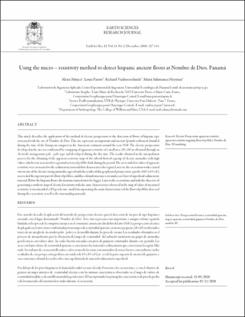| dc.contributor.author | Mojica, Alexis | |
| dc.contributor.author | Pastor, Louis | |
| dc.contributor.author | Vanhoeserlande, Richard | |
| dc.contributor.author | Salamanca, María | |
| dc.date.accessioned | 2017-08-09T19:24:53Z | |
| dc.date.accessioned | 2017-08-09T19:24:53Z | |
| dc.date.available | 2017-08-09T19:24:53Z | |
| dc.date.available | 2017-08-09T19:24:53Z | |
| dc.date.issued | 2010-07-02 | |
| dc.date.issued | 2010-07-02 | |
| dc.identifier.uri | http://ridda2.utp.ac.pa/handle/123456789/2532 | |
| dc.identifier.uri | http://ridda2.utp.ac.pa/handle/123456789/2532 | |
| dc.description | This article describes the application of the method of electric prospection to the detection of floors of hispanic type associated with the site of Nombre de Dios. This site represents an important and ancient Spanish settlement founded during the time of the European conquest in the American continent around the year 1510. The electric prospection developed in the site was conformed by a mapping of apparent resistivity of a small area (10 x 10) m obtained through an electrode arrangement pole - pole type and developed during the dry time. The results obtained in the interpolation process for the obtaining ofthe apparent resistivity map ofthe subsoil showed a group ofelectric anomalies withhigh values, whichwentassociatedto agroundsystemofpebbles built duringthe period. The areaswithlowvalues ofapparent resistivity were associated to the sedimentary material that characterizes the region. Later on, the excavation works carried out on one of the electric strong anomalies agreed with the results of this geophysical prospection; a probe of 0.5 x 0.5 x 0.2 m revealed the superior part of afloorofpebbles; and this colonial structure rests under a wet layer of superficial sedimentary material. Below the hispanic floors, the moisture turned out to be bigger. Later to the excavations, and with the objective of generating asynthetic map ofelectricalresistivitywiththe same characteristics observed in the map ofvalues ofmeasured resistivity, it was intended a 3D geoelectric model incorporating the main characteristics ofthe floor ofpebbles detected during the excavation, as well as the surrounding materials. | en_US |
| dc.description.abstract | This article describes the application of the method of electric prospection to the detection of floors of hispanic type associated with the site of Nombre de Dios. This site represents an important and ancient Spanish settlement founded during the time of the European conquest in the American continent around the year 1510. The electric prospection developed in the site was conformed by a mapping of apparent resistivity of a small area (10 x 10) m obtained through an electrode arrangement pole - pole type and developed during the dry time. The results obtained in the interpolation process for the obtaining ofthe apparent resistivity map ofthe subsoil showed a group ofelectric anomalies withhigh values, whichwentassociatedto agroundsystemofpebbles built duringthe period. The areaswithlowvalues ofapparent resistivity were associated to the sedimentary material that characterizes the region. Later on, the excavation works carried out on one of the electric strong anomalies agreed with the results of this geophysical prospection; a probe of 0.5 x 0.5 x 0.2 m revealed the superior part of afloorofpebbles; and this colonial structure rests under a wet layer of superficial sedimentary material. Below the hispanic floors, the moisture turned out to be bigger. Later to the excavations, and with the objective of generating asynthetic map ofelectricalresistivitywiththe same characteristics observed in the map ofvalues ofmeasured resistivity, it was intended a 3D geoelectric model incorporating the main characteristics ofthe floor ofpebbles detected during the excavation, as well as the surrounding materials. | en_US |
| dc.language | eng | |
| dc.language.iso | eng | en_US |
| dc.rights | https://creativecommons.org/licenses/by-nc-sa/4.0/ | |
| dc.rights | info:eu-repo/semantics/openAccess | |
| dc.subject | Electric Prospection | en_US |
| dc.subject | apparent resistivity | en_US |
| dc.subject | apparent resistivity mapping | en_US |
| dc.subject | floor of pebbles | en_US |
| dc.subject | Nombre de Dios | en_US |
| dc.subject | 3D modeling | en_US |
| dc.subject | Electric Prospection | |
| dc.subject | apparent resistivity | |
| dc.subject | apparent resistivity mapping | |
| dc.subject | floor of pebbles | |
| dc.subject | Nombre de Dios | |
| dc.subject | 3D modeling | |
| dc.title | Using the Micro – Resistivity Method to Detect Hispanic Ancient Floors at Nombre de Dios, Panama | en_US |
| dc.type | info:eu-repo/semantics/article | |
| dc.type | info:eu-repo/semantics/publishedVersion | |
